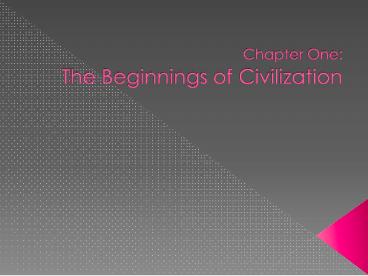Chapter One: The Beginnings of Civilization PowerPoint PPT Presentation
1 / 43
Title: Chapter One: The Beginnings of Civilization
1
(No Transcript)
2
(No Transcript)
3
- Urban life permanent constructions
- System of regulatory government
- Class distinction (wealth and occupation)
- Tools/skills -- production/trade
- Written communication
- Shared system of religious belief
- Not a value judgment!
4
- Paleolithic World View (Old Stone Age)
- Art
- Religion
- Neolithic Civilizations (Late Stone Age)
- Domestication of animals
- Cultivation of vegetation
- Community
- War / Weaponry
5
- Image 1.1
- Hall of the Bulls Lascaux
6
- Image 1.2
- Venus of Willendorf
7
- Mesopotamia
- Sumerian (3500-2350 B.C.E.)
- Semitic (2350-612 B.C.E.)
- Egypt
- Aegean Cultures
8
- Agricultural/Urban settlements
- Fertile Crescent
- Writing/record-keeping Cuneiform
- Shared system of religious belief
- Civil ruler / Religious rulers
9
- Gilgamesh ruled at Uruk c. 2700 B.C.E.
- Composed in Sumerian (2000 B.C.E.) on cuneiform
tablets - Pessimistic work
- Asserts universal questions about human existence
10
- Akkadian Period
- King Sargon and descendants (2350-2150 B.C.E.)
- Focus on HUMAN achievement
- Gutian invasion / return to tradition
- Babylonian Legacy
- King Hammurabi
- Assyrians
- Culmination of Mesopotamian culture
11
- Image 1.7
- Ziggurat at Ur
12
- Image 1.8
- Seated Statue of Gudea
13
- Image 1.9
- Stele of Hammurabi
14
- Medes
- Nomadic warriors
- Conquered Nineveh in 612 B.C.E.
- Conquered and absorbed by Persians
- Persians
- Nomadic warriors
- Conquered by Alexander the Great (330 B.C.E.)
15
- Manethos History of Egypt (in Greek)
- 31 dynasties / 4 groups
- Old Kingdom (2700 B.C.E.)
- Middle Kingdom (1990 B.C.E.)
- New Kingdom (1570 B.C.E.)
- Late Period (1185-500 B.C.E.)
16
- Unified and consistent
- Resistant to change
- Worldview affected by external events
17
- Pharaoh
- Head of the central government
- Regarded as a living god
- Exercised absolute power
- Ordered and controlled visible world
- Priests
- Preservation of religious beliefs
- Divine kingship of Pharaohs
18
- Obsession with immortality / life after death
- Book of the Dead
- Osiris, Isis, Horus
- Deities, subdeities, nature spirits
- Responsible for all aspects of existence
19
- Principal function of artists to produce images
of deities - Form of worship
- Standards set forth by Pharaoh
- Artists also provided temples and shrines for
honoring deities
20
- Imhotep
- First architect known to history
- Pyramids
- Funerary monuments for pharaohs, upper class
- Mummification
- Preservation of the body was necessary for the
survival of the soul
21
- Pyramids at Giza (Dynasty IV)
- Cheops
- Chefren
- Mycerinus
- Who built the pyramids?
- Farmers
- Slaves
22
- Constructed of limestone blocks
- Quarried, ferried, cut, dragged into place
- Center chamber contained mummified body of
pharaoh surrounded by treasures - Plundered by robbers
23
- Created as the guardian for Chefrens tomb at
Giza - Adopted as a divine symbol of the mysterious and
enigmatic (Greeks)
24
- Image 1.12
- Great Sphinx
25
- Reflects confidence and certainty
- Idealized realism
- Conceptual, symbolic
26
- Loss of trust in divine providence
- Artists attempted to recapture lofty serenity of
Old Kingdom - Troubled spirit captured in weight and somber
expressions
27
- Artistic traditions continued
- Conceptual
- Pharaoh Amenhotep IV/ Akhenaton
- Massive religious/political reform
- Tel el-Amarna Art
- Tutankhamen
- Howard Carter (1922-1923)
28
- Image 1.15
- Akhenaton, Nefertiti, and Three of Their Children
29
- Image 1.16
- Queen Nefertiti
30
- Image 1.18
- Death Mask of Tutanhkamen
31
- Image 1.19
- Temple of Ramses II
32
- Artists revisited earlier period styles
- Recapture realism, volume
- Return to pyramid-shaped tombs
- Egypt invaded by Nubians (the Cush) 750-720
B.C.E. - Nubians and Nobatae preserved ancient culture
33
- Crete
- King Minos / Knossos
- Cyclades Islands
- Bronze tools
- Imaginative/humorous pottery
- Marble statues/idols
34
- Image 1.21
- Cycladic Idol
35
- Arthur Evans, 1894-1900
- Early Minoan
- Increasing growth
- Contacts with Egypt and Mesopotamia
- Scattered Towns
36
- Evolution of large urban centers
- Art lively and colorful
- Little interest in monumental art
- Writing system of hieroglyphic signs
37
- Image 1.22
- Palace of Minos at Knossos
38
- Image 1.25
- Wasp Pendant
39
- Image 1.27
- Snake Goddess
40
- Period of rebuilding after earthquakes
- High point of Minoan culture
- Wall paintings
- Religion centered upon mother goddess connected
with fertility
41
- Image 1.28
- Funerary Mask
42
- Heinrich Schliemann, 1870-1873
- The Trojan War (1250 B.C.E.)
- Strongly influenced by Minoan Culture
- Art preoccupied with death and war
- Fall of the Mycenaean empire (1200 B.C.E.)
43
- What can be determined about the roles of women
in early civilizations based on their artistic
depictions? Explain, citing examples from each
culture. - Based on the universal questions evoked in the
Epic of Gilgamesh, what can we assume about the
Sumerian people and their lifestyles? In what
ways are their concerns shared by people of our
culture and generation? Explain. - What role did geography play in the development
and preservation of Ancient Egyptian culture? In
what fundamental ways was Egyptian culture
different from the Mesopotamian and Aegean
cultures? - Discuss the role of the archeologist. What impact
do the discoveries of ancient cultures have on us
today? Explain.

